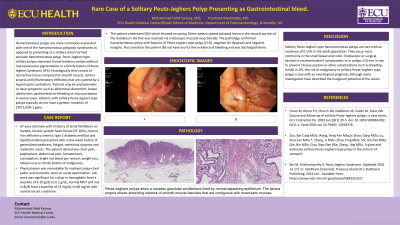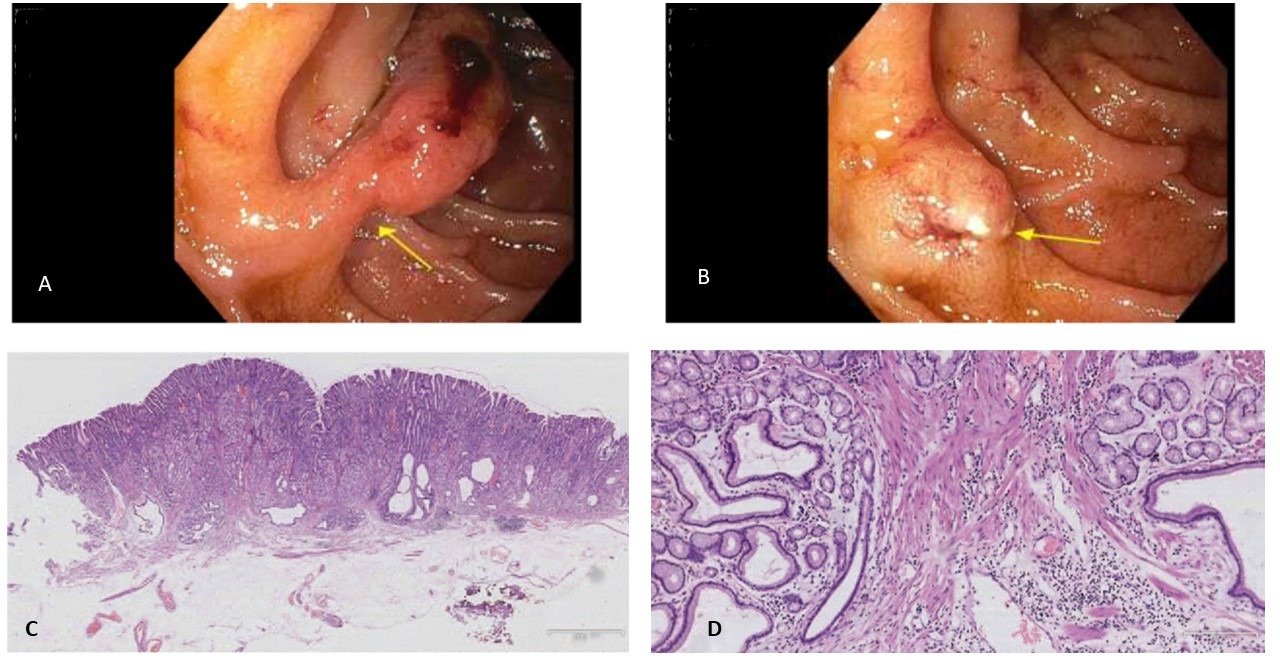Monday Poster Session
Category: General Endoscopy
P2011 - Rare Solitary Peutz-Jeghers Type Duodenal Polyp Presenting With Gastrointestinal Bleed
Monday, October 23, 2023
10:30 AM - 4:15 PM PT
Location: Exhibit Hall

Has Audio

Muhammad Farooq, MD
East Carolina University
Greenville, NC
Presenting Author(s)
Muhammad Farooq, MD1, Mohammad H. Farooq, MD2, Prashant Mudireddy, MD1
1East Carolina University, Greenville, NC; 2Shifa College of Medicine, Greenville, NC
Introduction: Hamartomatous polyps are more commonly associated with one of the hamartomatous polyposis syndromes as opposed to presenting as a solitary lesion termed sporadic hamartomatous polyp. Peutz-Jeghers type solitary polyps represent hamartomatous polyps without mucocutaneous pigmentation or a family history of Peutz-Jeghers Syndrome (JPS). Histologically they consist of connective tissue composed of smooth muscle, lamina propria and inflammatory infiltrates that are covered by a hypertrophic epithelium. Patients may be asymptomatic or have symptoms such as abdominal discomfort, bowel obstruction, gastrointestinal bleeding or intussusception in severe cases. Patients with solitary Peutz-Jeghers type polyps typically do not have a genetic mutation of STK11/LKB-1 gene.
Case Description/Methods: A 67-year-old male with a history of atrial fibrillation on Xarelto, chronic systolic heart failure (EF 20%), chronic iron deficiency anemia, type 2 diabetes mellitus and hypothyroidism presented with a one week history of generalized weakness, fatigue, exertional dyspnea and melanotic stools. The patient denied any chest pain, palpitations, abdominal pain, hematemesis, constipation, bright red blood per rectum, weight loss, tobacco use or family history of malignancy. Physical exam was remarkable for marked conjunctival pallor and melanotic stool on rectal examination. Lab work was significant for a drop in hemoglobin from a baseline of 9-10 g/dL to 6.1 g/dL, normal MCV and rise in BUN from a baseline of 22 mg/dL to 68 mg/dL with normal serum creatinine. The patient underwent EGD which showed an oozing 25mm pedunculated polypoid lesion in the second portion of the duodenum (A) that was resected via endoscopic mucosal resection (B). The pathology was externally reviewed and confirmed hamartomatous polyp with features of Peutz-Jeghers type polyp (C+D), negative for dysplasia and negative margins. Post resection the patient did not have any further evidence of bleeding and was discharged home.
Discussion: Solitary Peutz-Jeghers type hamartomatous polyps are rare with an incidence of 0.15% in the adult population. They occur most commonly in the small bowel and colon. Endoscopic or surgical excision is recommended if symptomatic or in polyps ≥10 mm in size to prevent intussusception or other complications such as bleeding. Unlike in JPS, the risk of malignancy in solitary Peutz–Jeghers-type polyps is low with an overall good prognosis although some investigators have described the malignant potential of the lesion.

Disclosures:
Muhammad Farooq, MD1, Mohammad H. Farooq, MD2, Prashant Mudireddy, MD1. P2011 - Rare Solitary Peutz-Jeghers Type Duodenal Polyp Presenting With Gastrointestinal Bleed, ACG 2023 Annual Scientific Meeting Abstracts. Vancouver, BC, Canada: American College of Gastroenterology.
1East Carolina University, Greenville, NC; 2Shifa College of Medicine, Greenville, NC
Introduction: Hamartomatous polyps are more commonly associated with one of the hamartomatous polyposis syndromes as opposed to presenting as a solitary lesion termed sporadic hamartomatous polyp. Peutz-Jeghers type solitary polyps represent hamartomatous polyps without mucocutaneous pigmentation or a family history of Peutz-Jeghers Syndrome (JPS). Histologically they consist of connective tissue composed of smooth muscle, lamina propria and inflammatory infiltrates that are covered by a hypertrophic epithelium. Patients may be asymptomatic or have symptoms such as abdominal discomfort, bowel obstruction, gastrointestinal bleeding or intussusception in severe cases. Patients with solitary Peutz-Jeghers type polyps typically do not have a genetic mutation of STK11/LKB-1 gene.
Case Description/Methods: A 67-year-old male with a history of atrial fibrillation on Xarelto, chronic systolic heart failure (EF 20%), chronic iron deficiency anemia, type 2 diabetes mellitus and hypothyroidism presented with a one week history of generalized weakness, fatigue, exertional dyspnea and melanotic stools. The patient denied any chest pain, palpitations, abdominal pain, hematemesis, constipation, bright red blood per rectum, weight loss, tobacco use or family history of malignancy. Physical exam was remarkable for marked conjunctival pallor and melanotic stool on rectal examination. Lab work was significant for a drop in hemoglobin from a baseline of 9-10 g/dL to 6.1 g/dL, normal MCV and rise in BUN from a baseline of 22 mg/dL to 68 mg/dL with normal serum creatinine. The patient underwent EGD which showed an oozing 25mm pedunculated polypoid lesion in the second portion of the duodenum (A) that was resected via endoscopic mucosal resection (B). The pathology was externally reviewed and confirmed hamartomatous polyp with features of Peutz-Jeghers type polyp (C+D), negative for dysplasia and negative margins. Post resection the patient did not have any further evidence of bleeding and was discharged home.
Discussion: Solitary Peutz-Jeghers type hamartomatous polyps are rare with an incidence of 0.15% in the adult population. They occur most commonly in the small bowel and colon. Endoscopic or surgical excision is recommended if symptomatic or in polyps ≥10 mm in size to prevent intussusception or other complications such as bleeding. Unlike in JPS, the risk of malignancy in solitary Peutz–Jeghers-type polyps is low with an overall good prognosis although some investigators have described the malignant potential of the lesion.

Figure: A: Endoscopic view of pedunculated Peutz-Jeghers type duodenal polyp. B: Post EMR appearance of polyp site.
C and D: Histology of Peutz-Jeghers type polyp showing connective tissue composed of smooth muscle covered by a hypertrophic epithelium.
C and D: Histology of Peutz-Jeghers type polyp showing connective tissue composed of smooth muscle covered by a hypertrophic epithelium.
Disclosures:
Muhammad Farooq indicated no relevant financial relationships.
Mohammad Farooq indicated no relevant financial relationships.
Prashant Mudireddy indicated no relevant financial relationships.
Muhammad Farooq, MD1, Mohammad H. Farooq, MD2, Prashant Mudireddy, MD1. P2011 - Rare Solitary Peutz-Jeghers Type Duodenal Polyp Presenting With Gastrointestinal Bleed, ACG 2023 Annual Scientific Meeting Abstracts. Vancouver, BC, Canada: American College of Gastroenterology.
